In the early moments of 6 April 1970, a desperate gun battle erupted between officers of the California Highway Patrol and two heavily armed felons in the unincorporated city of Newhall, California. The felons killed four officers, making the “Newhall Shooting” one of the most deadly law enforcement gunfights of the modern era, and the most deadly in the history of the California Highway Patrol (CHP).
The last officer slain by the felons was killed while attempting to reload his revolver and get back into the fight. Officer James E. Pence, Jr. had just completed filling the cylinder of his Colt Python with loose cartridges from his dump pouch, and was in the process of closing the cylinder, when he was killed with an execution-style shot to the back of his head.
From Tragedy, Growth
In the aftermath of the shooting, the circumstances surrounding Officer Pence’s death drew the attention of CHP investigators, who determined that a more efficient means of carrying spare cartridges was required. Shortly thereafter, the CHP became the first law enforcement agency of its size to issue speedloaders to all of its uniformed personnel.
The practice spread, and by the mid-1970s, the revolver speedloader–once the sole domain of competition shooters–was quickly becoming a mainstay of police equipment throughout America. While some agencies stubbornly clung to loops and dump pouches until they transitioned to semiauto pistols, the majority of revolver-equipped departments had upgraded to speedloaders by the close of the decade.
Let’s take a look at some of the more popular designs adopted by police in this early era, most of which have disappeared in the years since.
Twists and Turns
In July of 1959, a patent was granted to John M. Hunt for a loading device that would be marketed as the Hunt Engineering, Inc. “Multi Loader.” Initial units were apparently manufactured by the legendary Pachmayr Gun Works, and it was later produced and marketed by both Kel-Lite and Safariland as the “Firepower Clip.”
The loader was a tapered cylinder of soft neoprene which held six cartridges in the appropriate pattern in its bottom face. It was hollow at the top, which allowed an index finger to reach inside and activate a release that freed it from the carrying pouch, and also to help push the loader into place on the cylinder. In practice, after the loader was mounted flush to the gun, it was carefully torn away, and the soft neoprene would stretch and release the rims of the cartridges, allowing them to gravity feed.
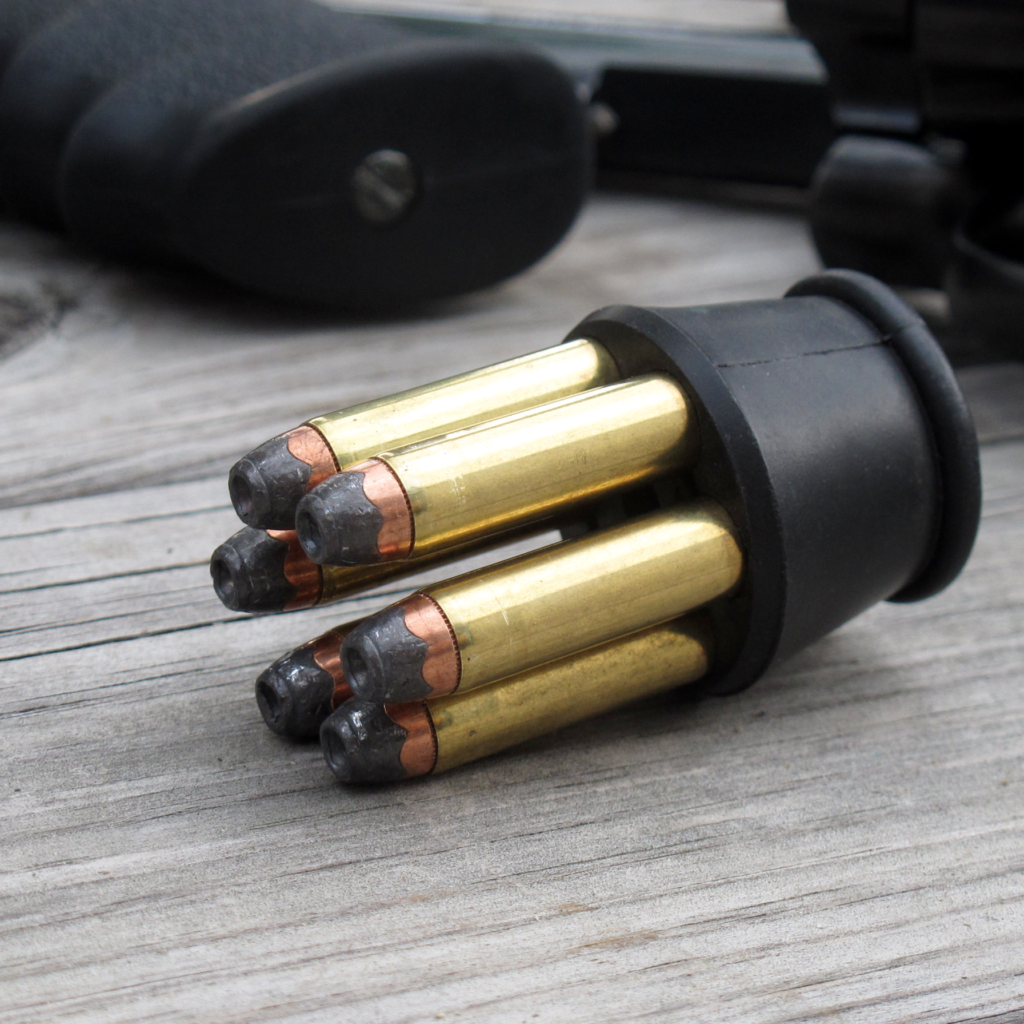
On the plus side, the loader was faster than traditional methods of loading loose rounds, and it held the cartridges very securely, even if dropped. It was thin enough that it didn’t get hung up too much on the left grip during loading. However, it had its faults. Since it wasn’t rigid, the rounds could flare outwards as the loader lost its shape over time in a pouch, making it harder to align with the chambers. Also, it required careful and practiced manipulation to avoid lifting the loader while tearing, which would drag cartridges out of the cylinder. Under stress, it was hard to get a clean release with this design.
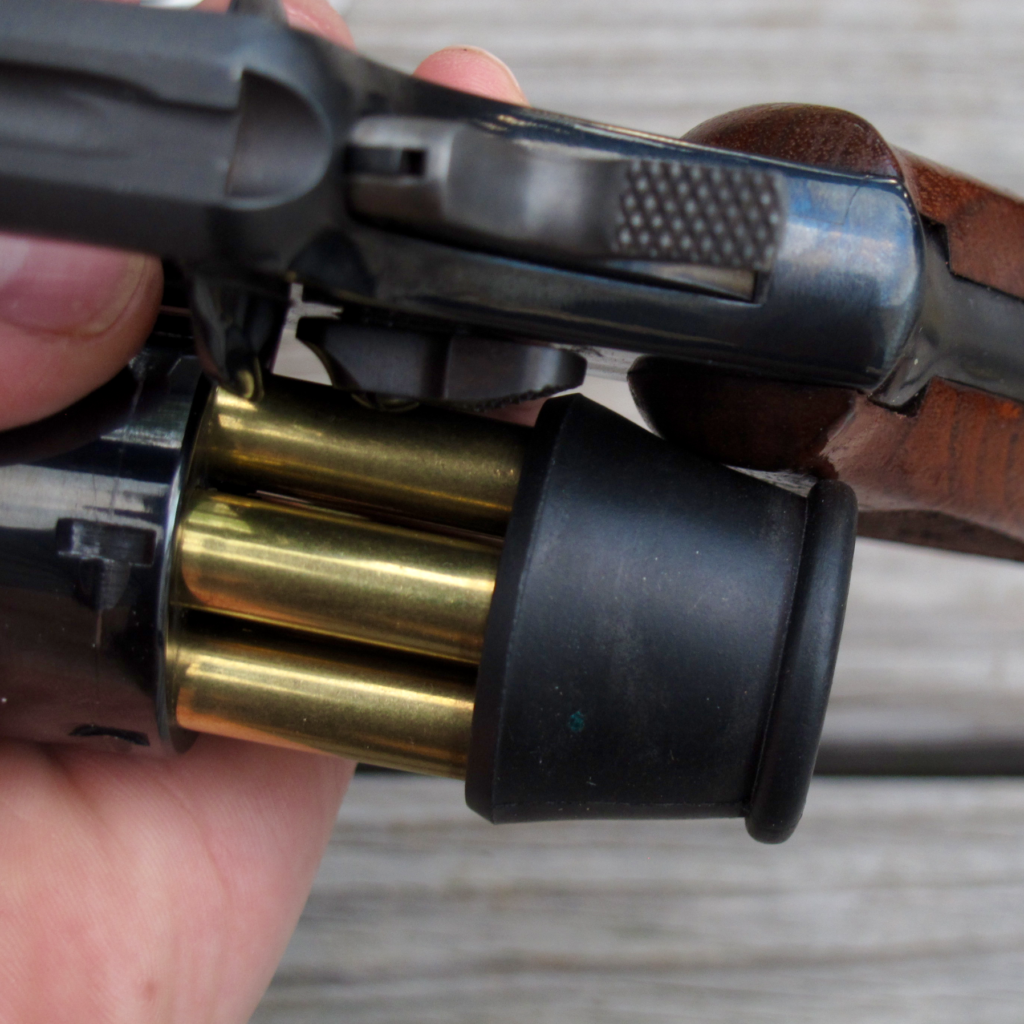
A much better design was Ole N. Nelson’s loader, patented in August of 1965. This was built by Salinas Industries and marketed by the popular police product distributor, J.M. Bucheimer. The Bucheimer loader was made of hard plastic and shaped like a fluted revolver cylinder. It held the cartridges in firm alignment, for easy insertion into the cylinder. After aligning the loader with the gun, a small push button at the rear was activated to release the cartridges and allow them to gravity feed into the cylinder. This loader was later marketed as the “Feathertouch” as well, in the early 1970s.
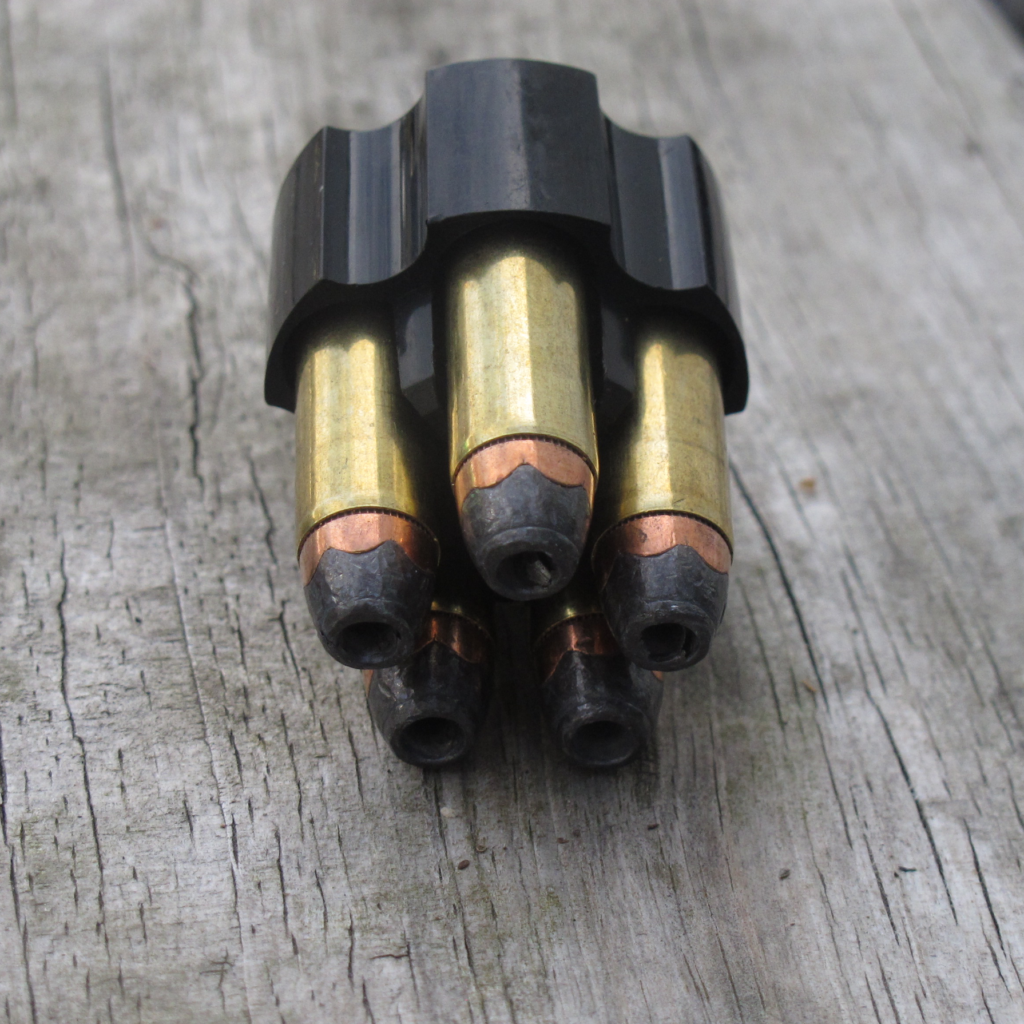
The Bucheimer / Feathertouch was quick to operate and did an admirable job of retaining cartridges if dropped, but the small button could be missed under stress and the loader body was thick enough that it often got hung up on the grip panel–a problem that was common to almost all of the loaders of the period. The release button was spongy, without a definite “click” to let the user know the payload had been dropped, which sometimes created problems, and some users back then reported that the loader didn’t always drop all of the rounds when activated. Still, it was a successful and fast design for the most part.
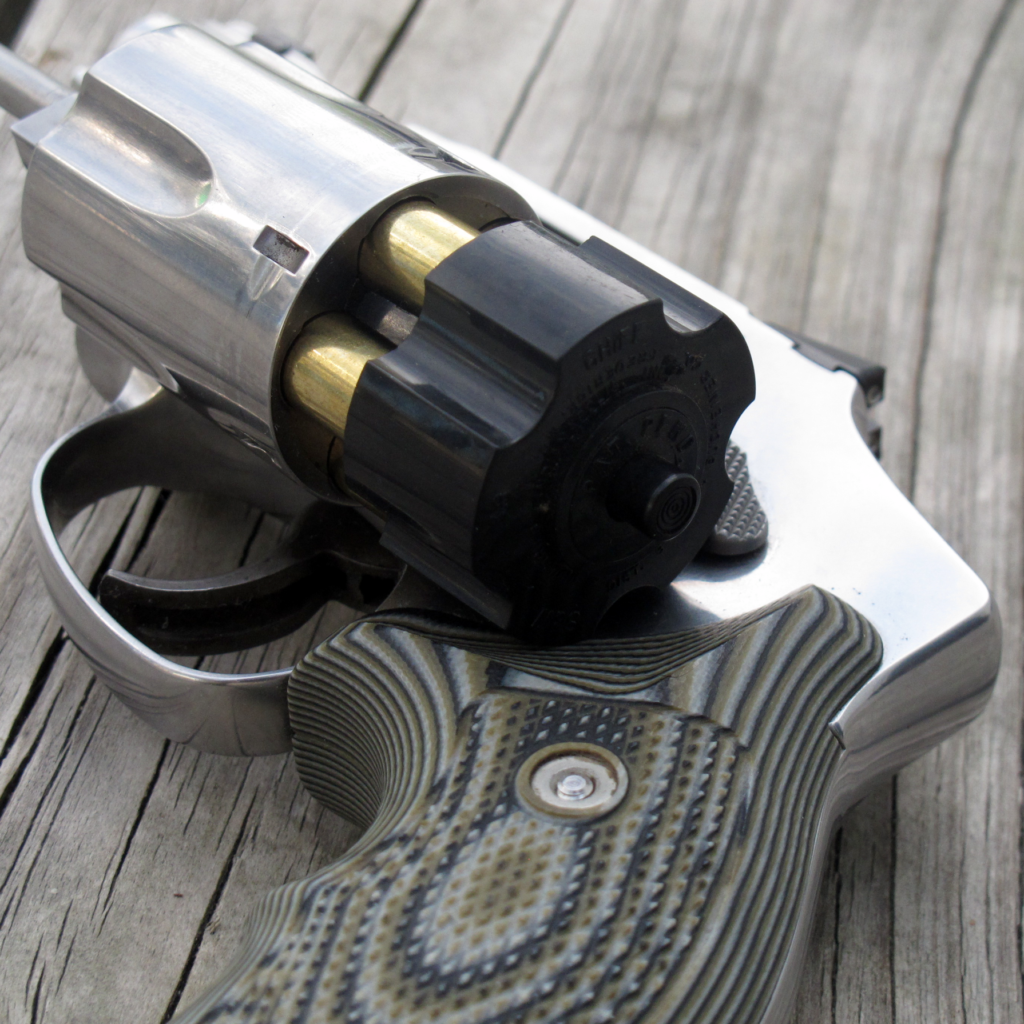
An especially unique design was the Quick Load, from Donald Matich, patented in October of 1965. The Matich Quick Load was a flexible neoprene strip with six claws that held each of the individual cartridges. It was loaded while flat, but when it was full of rounds, it was rolled up into a cylinder shape and secured with a clasp.
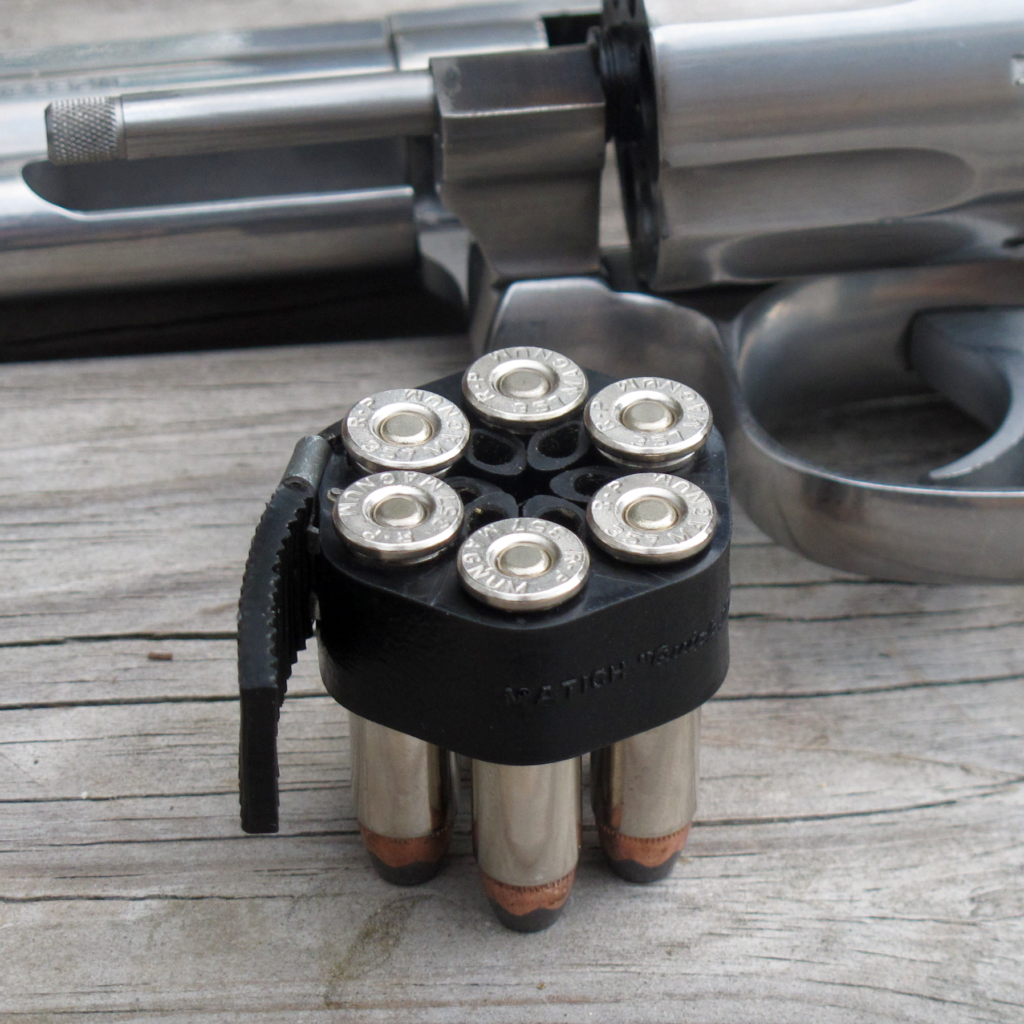
In practice, the Quick Load was mated to the cylinder and the clasp was undone by pulling on a tab. Continuing to pull the tab would peel the loader away from the trapped cartridges, leaving the cylinder spinning like a top.
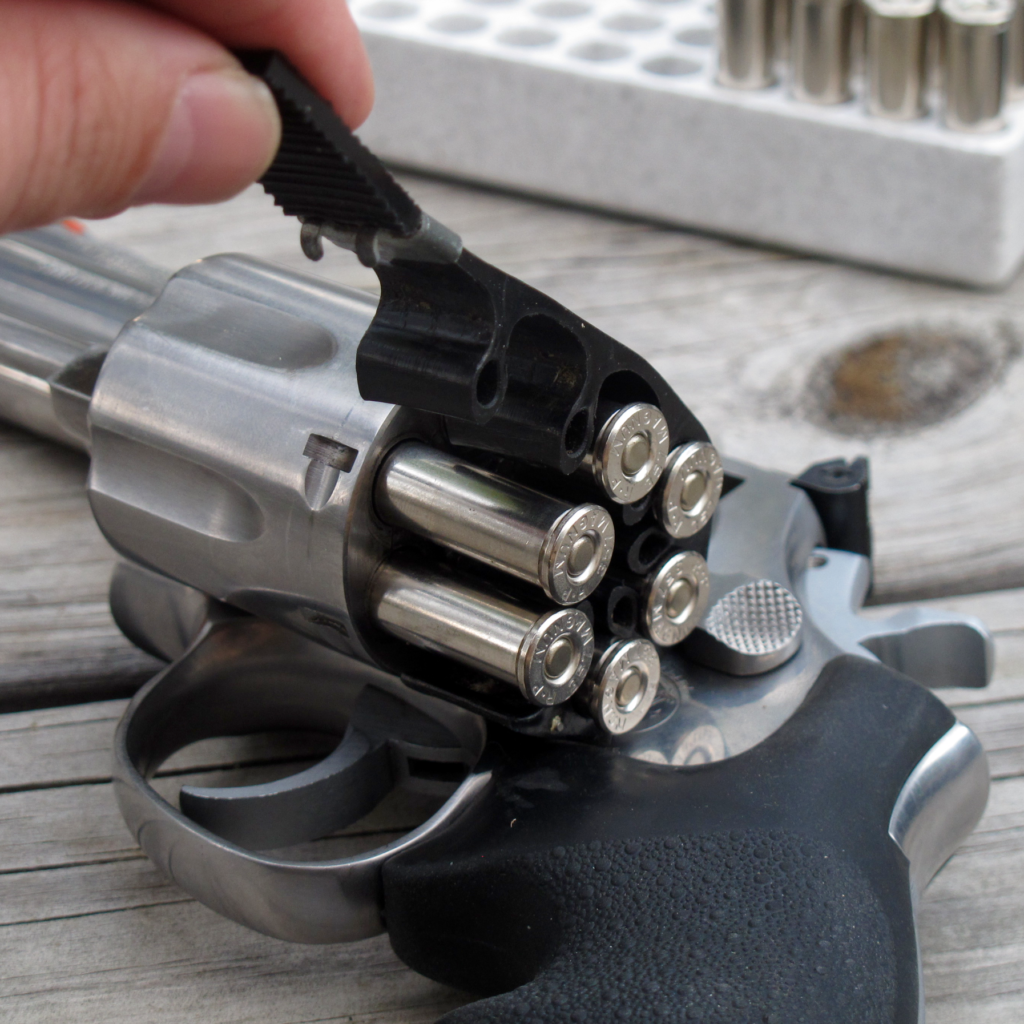
The Matich was thin and didn’t suffer the interference problems of some other loaders. It also held rounds very securely when dropped. The biggest problem with this loader is that (like the Hunt) it was very sensitive to user technique, and it tended to pull some cartridges out of the cylinder during loading.
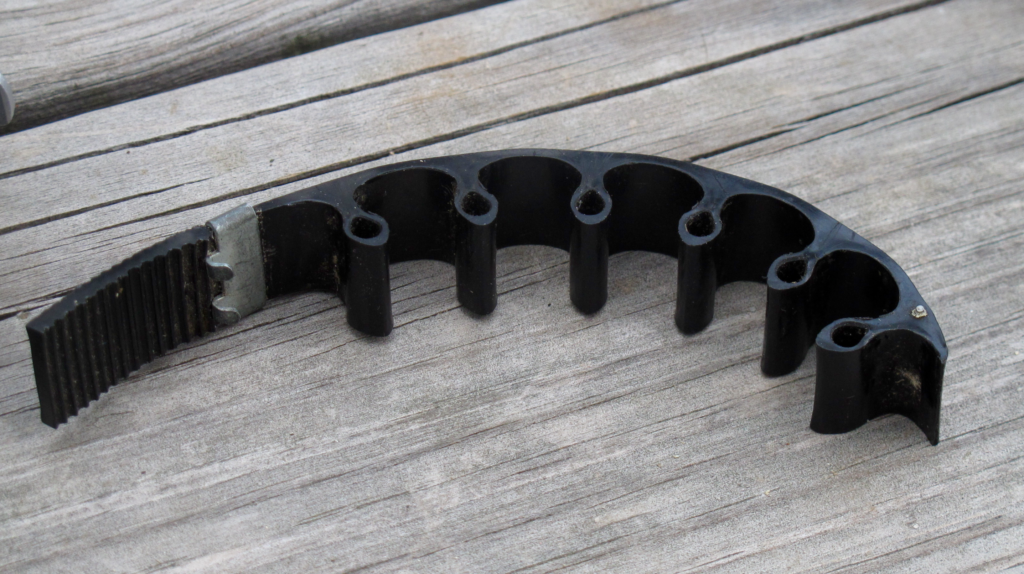
The design from John D. Fordham, patented in November 1970 and marketed by Dade Screw Machine Products, did a much better job of releasing the payload cleanly, and became very popular. Like the Bucheimer / Feathertouch, the Dade worked via a rear-mounted push button, which released the cartridges to gravity feed into the cylinder.
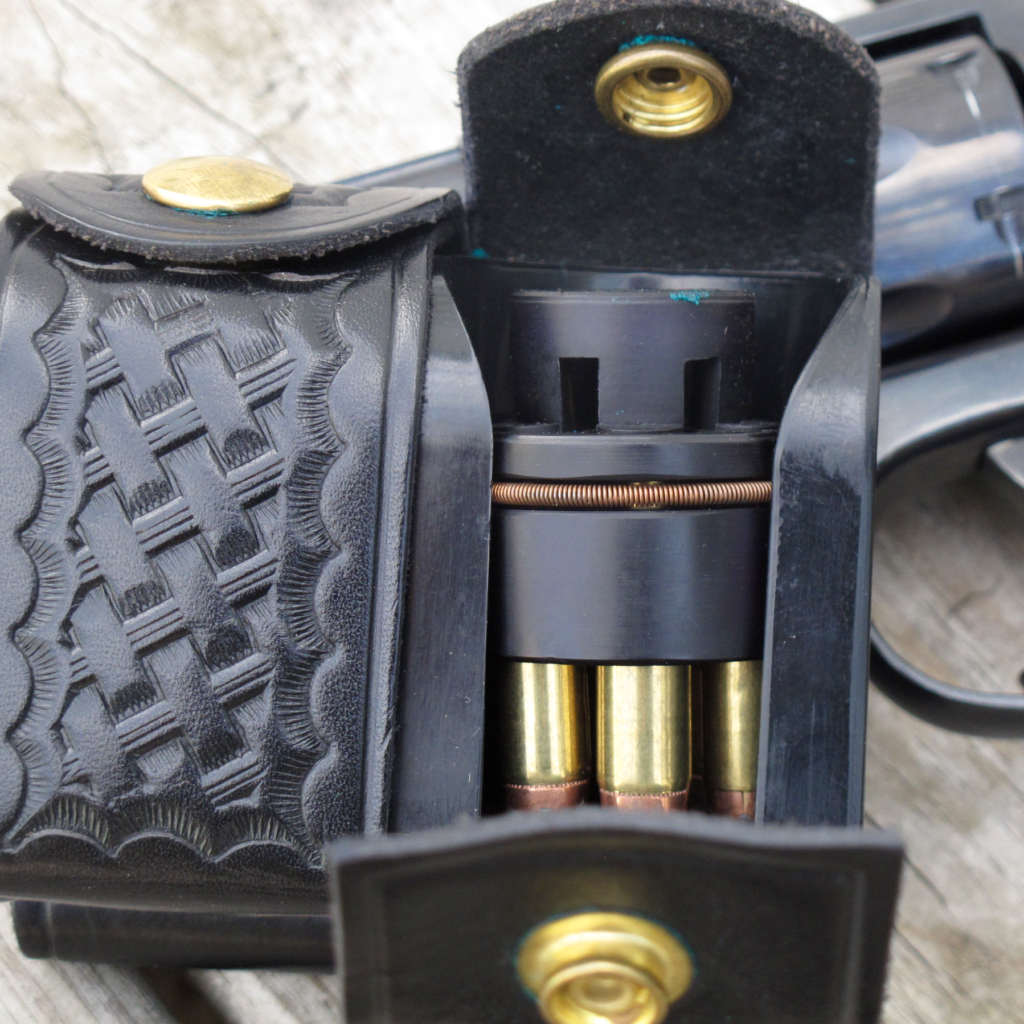
The Dade’s release button was much larger though (with a head about the size of a Quarter, instead of the small post of the Bucheimer, which looked like a click-top pen) and couldn’t be missed. Whereas the Bucheimer used a flexible, internal washer to hold the cartridge rims in place, the Dade retained cartridges by means of a coil spring that wrapped around the outside of the plastic loader body. The spring engaged the rims of the cartridges and held them in the loader until the push button forced the rims past the expanding spring.
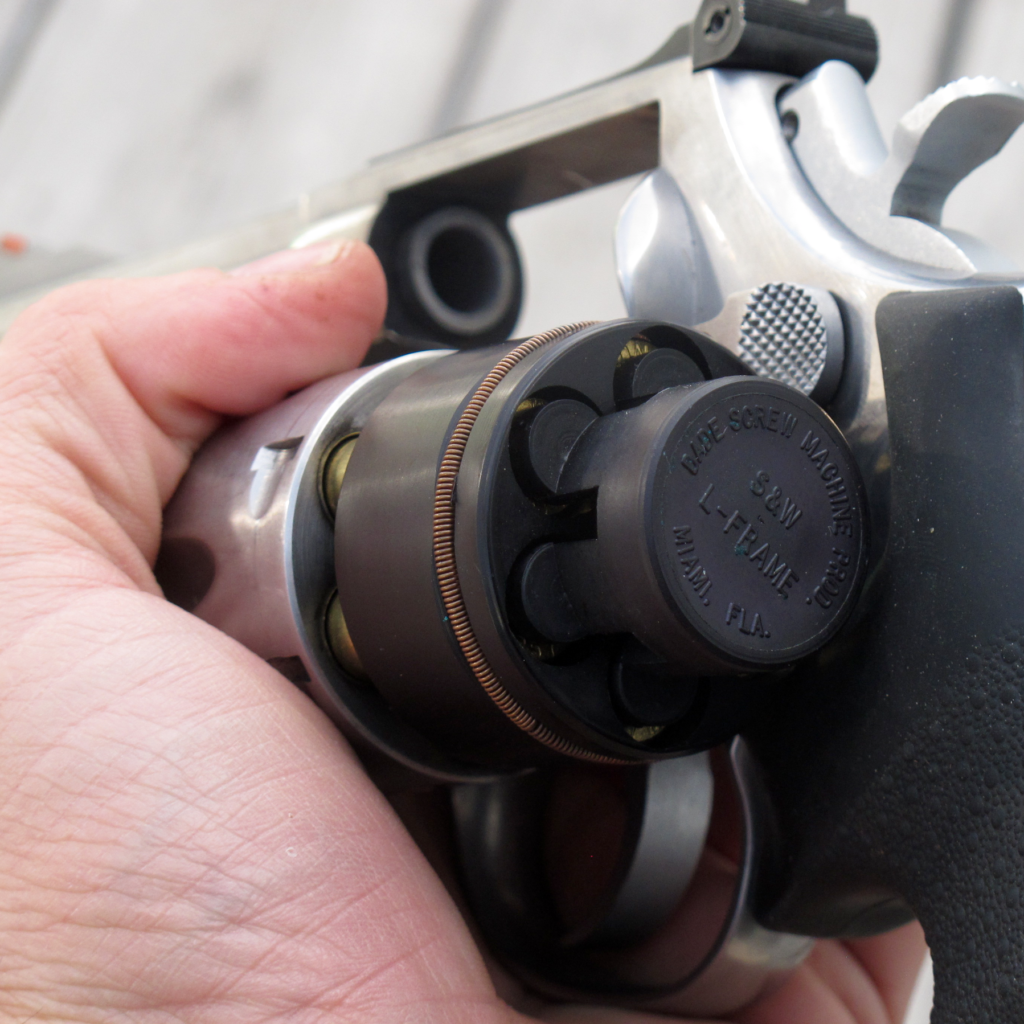
The Dade was easier to operate than the Bucheimer, and was very fast, which made it very popular with competitors of the day. However, the Dade was very prone to spilling cartridges if dropped, and its fat body created interference issues with grips that had not been relieved. The large push button which made it so quick to operate also gave it a tendency to discharge when carried in a pocket, so a proper carrier was mandatory. While it’s no longer being manufactured, the essence of the design survives in today’s Speed Beez loader.
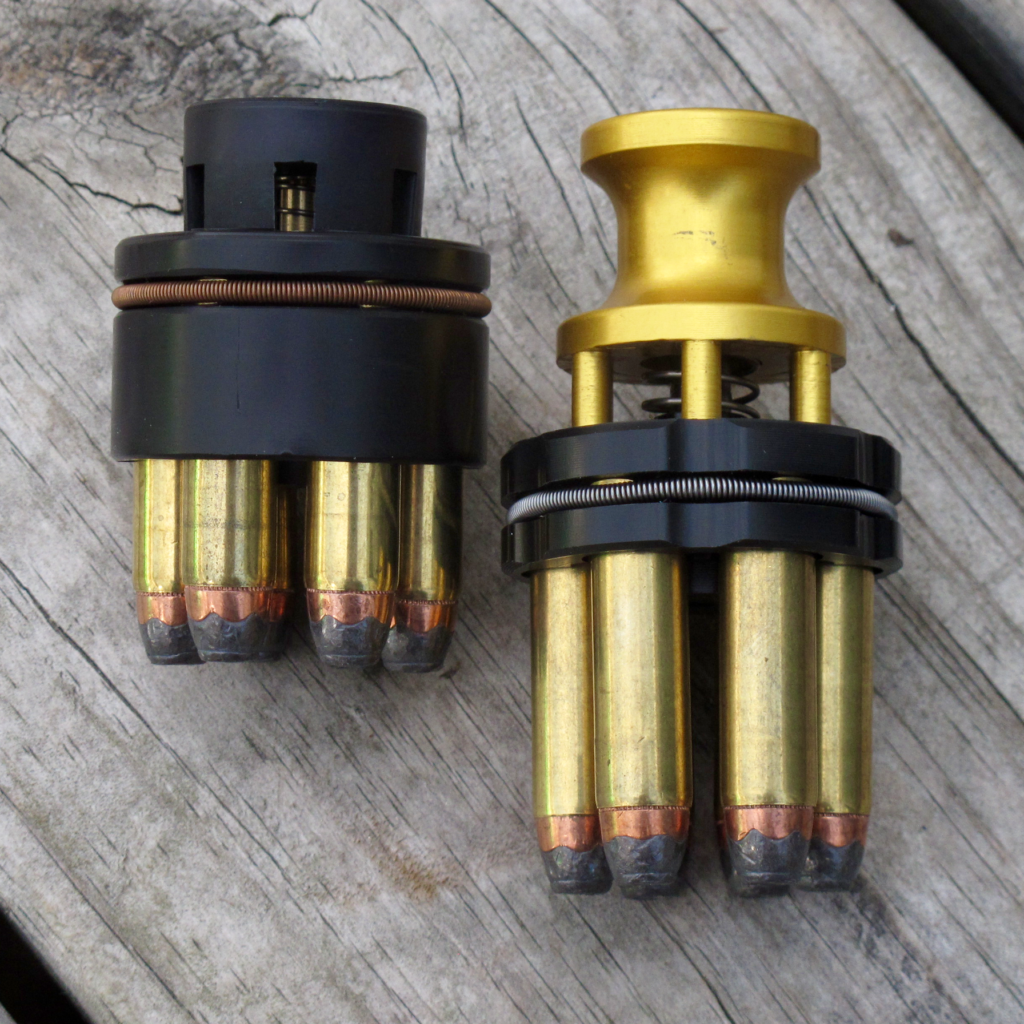
In November of 1973, William T. Griffis was granted a patent on his unique design for a loader with a skeletonized plastic body and a ring around the outside that slid up and down the length of the loader. The ring engaged the cartridge rims, and when it was shoved forward towards the cylinder, it forced the cartridges out of the loader and into the gun. The advantage of the system is that it didn’t rely on gravity to load the cartridges, so its operation was independent of the orientation of the gun. The gun could be positively charged even if it was angled upwards or laying on its side, and this feature made it popular with police, who understood that they might have to load from awkward positions, or with one hand, without being able to orient the gun with the muzzle straight down. Griffis sold the design as the “Second Six,” and restricted its sale to police. It had the distinction of being issued by the CHP, Los Angeles County Sheriff’s Department, and other influential agencies.
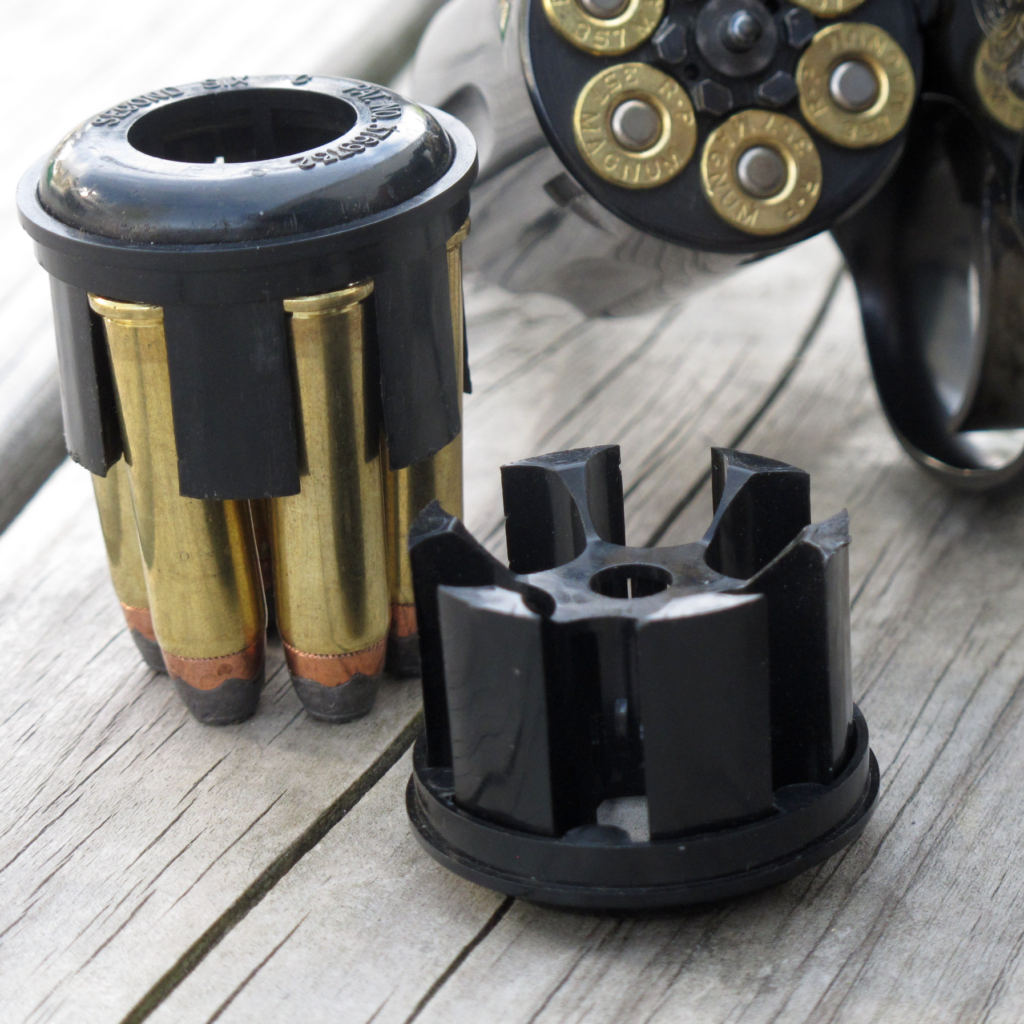
The Second Six was pretty fast, and a skilled user could match the Dade for speed. The loader body was narrow and cleared grip panels better than some of its competitors, but sometimes the sliding ring could bind on a grip that was not properly relieved, which prevented operation. Unfortunately, it did a poor job of retaining cartridges if dropped, and it wasn’t marketed well enough to gain popularity outside of California. The loader was very durable, but a small annoyance was that the charging ring would sometimes pop off the loader when used, and the user would have to find the piece and reassemble the loader, later.
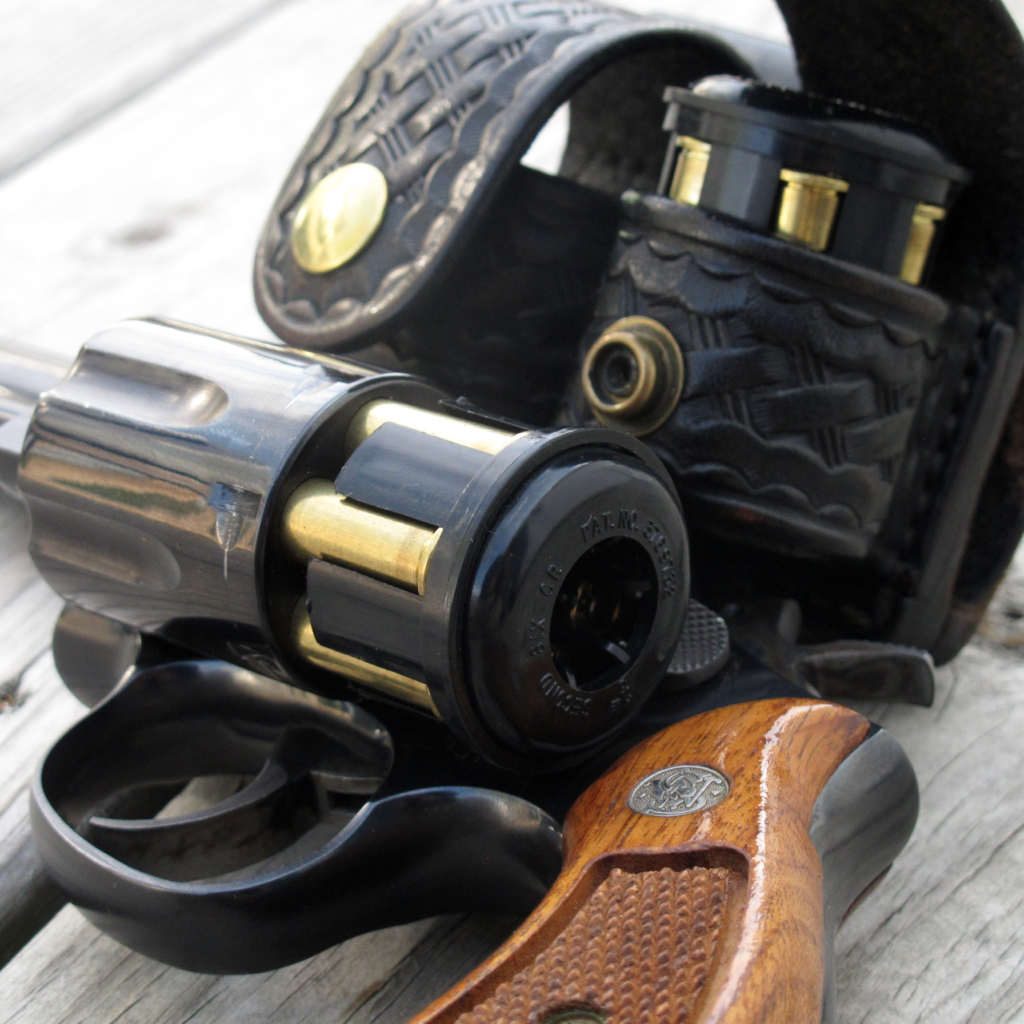
Survivors
All those loaders have faded away in the years since, but two more designs from the era still survive. The round loader with the best staying power of all was the design of Robert D. Switzer, who received his patent in March of 1973. Switzer’s loader (manufactured and sold by HKS as the “Six Second”) uses a large, central, twist knob to lock and release the rims of the cartridges, which then gravity feed into the gun. A spring loaded detent keeps the knob in position, preventing accidental discharges.
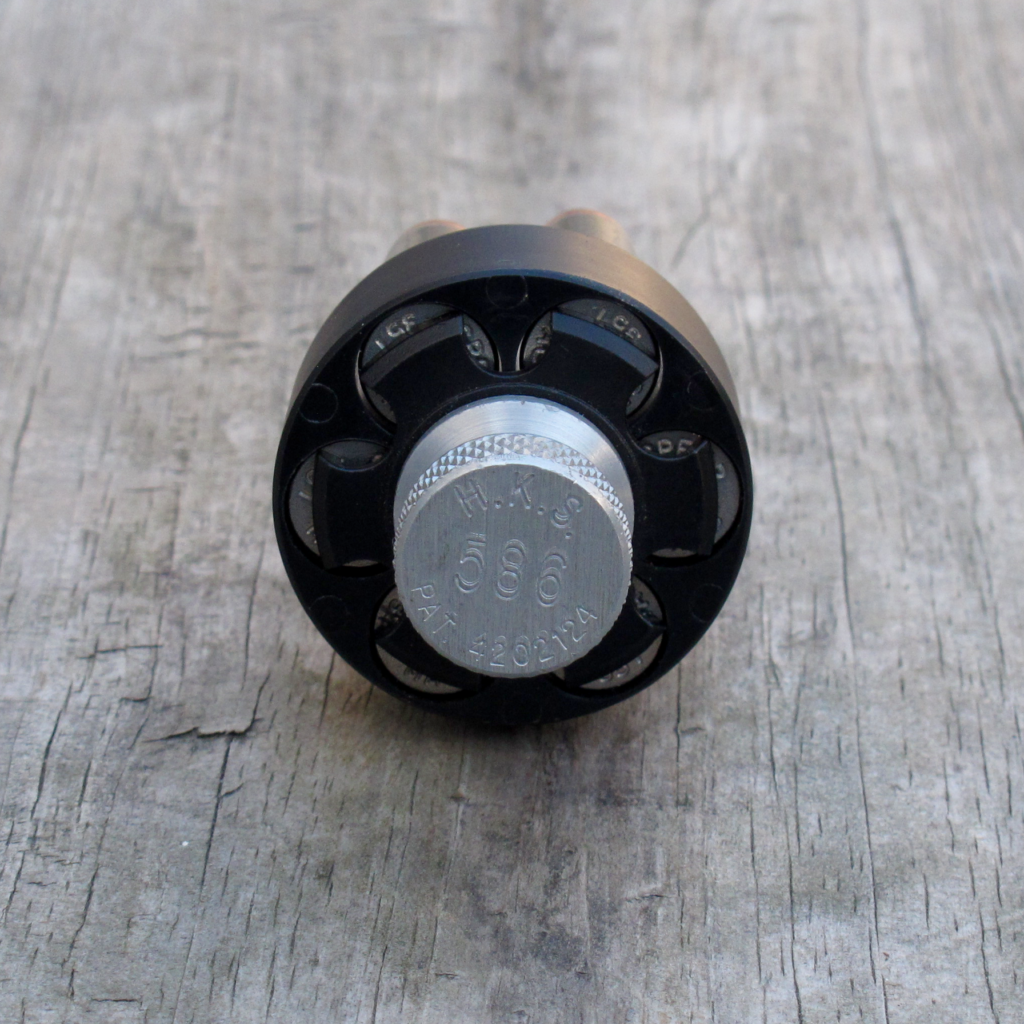
The HKS Six Second offered the best payload retention of all the loaders from this era, stubbornly holding onto all the cartridges, no matter how harshly the loader was treated. This tremendous advantage was slightly offset by the fact that the loader requires the cylinder to be trapped in place, to prevent rotation as the knob is twisted to release the cartridges. This makes the HKS loader more difficult to operate with one hand, if the user is injured. Additionally, the loader body is fat enough to cause interference problems on a lot of grip panels.
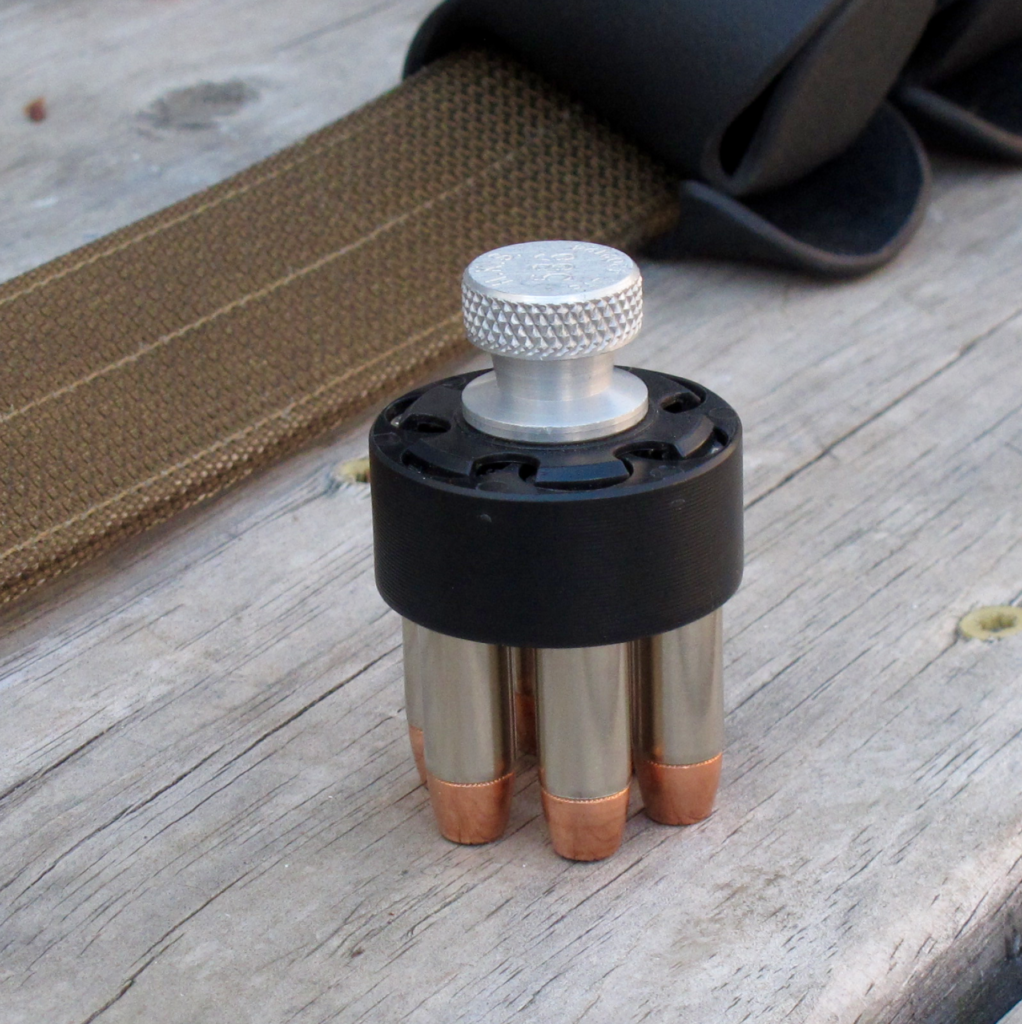
Solid marketing, a diverse array of models, superior security, and rugged simplicity saved the day for the HKS, however. It quickly became a police and consumer favorite, and it remains the most prolific round body loader to this day.
The other favorite from the era is the John Bianchi-designed “Speed Strip,” which was trademarked in 1965, but not seen in the catalog until 1972 (thanks to American Handgunner Editor Roy Huntington for helping to track down that date). Bianchi’s design consisted of a narrow, hard rubber strip, with a spring steel core (later, an all-composite design), that allowed the user to load six cartridges in line. In practice, the user aligns one or two cartridges at a time into the chambers, and peels the Speed Strip away from the cylinder face, causing the rubber to lose its grip on the cartridge rims.
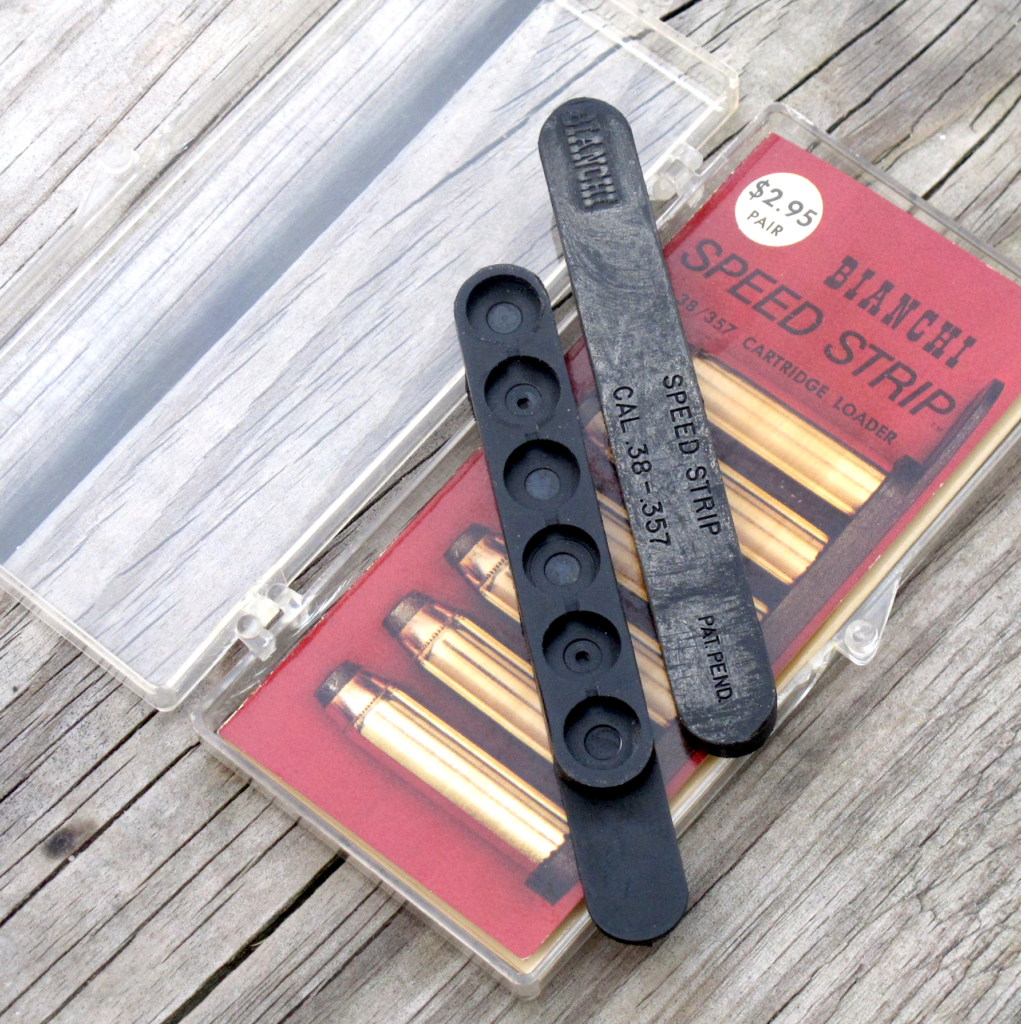
The Speed Strip was an instant hit, particularly with officers who were required to use dump pouches, because they provided better control of the payload. A skilled user could become very fast with a Speed Strip (which was always faster and more positive than loading loose rounds from loops or dump pouches), and like the HKS, they did a marvelous job of retaining cartridges when dropped.
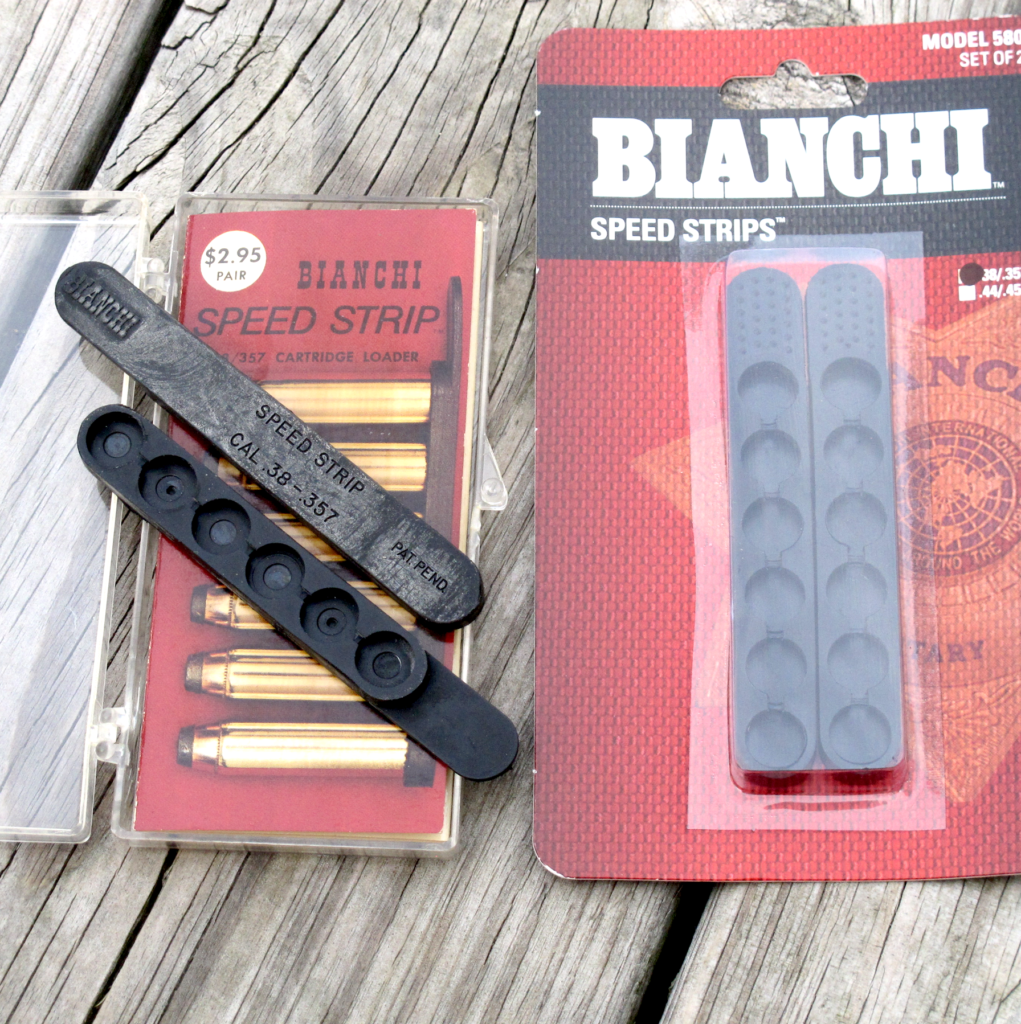
The flat and compact nature of the Speed Strip made it a favorite for plainclothes, off duty, or backup use, and many officers carried one or two in a shirt or pants pocket to back up other, round body speedloaders on the uniform belt. The Speed Strip can simply go places and do things that most round body loaders cannot, making it the only loader to rival the popularity of the HKS. Numerous copies of the Speed Strip have been marketed by competitors in the years since its introduction.
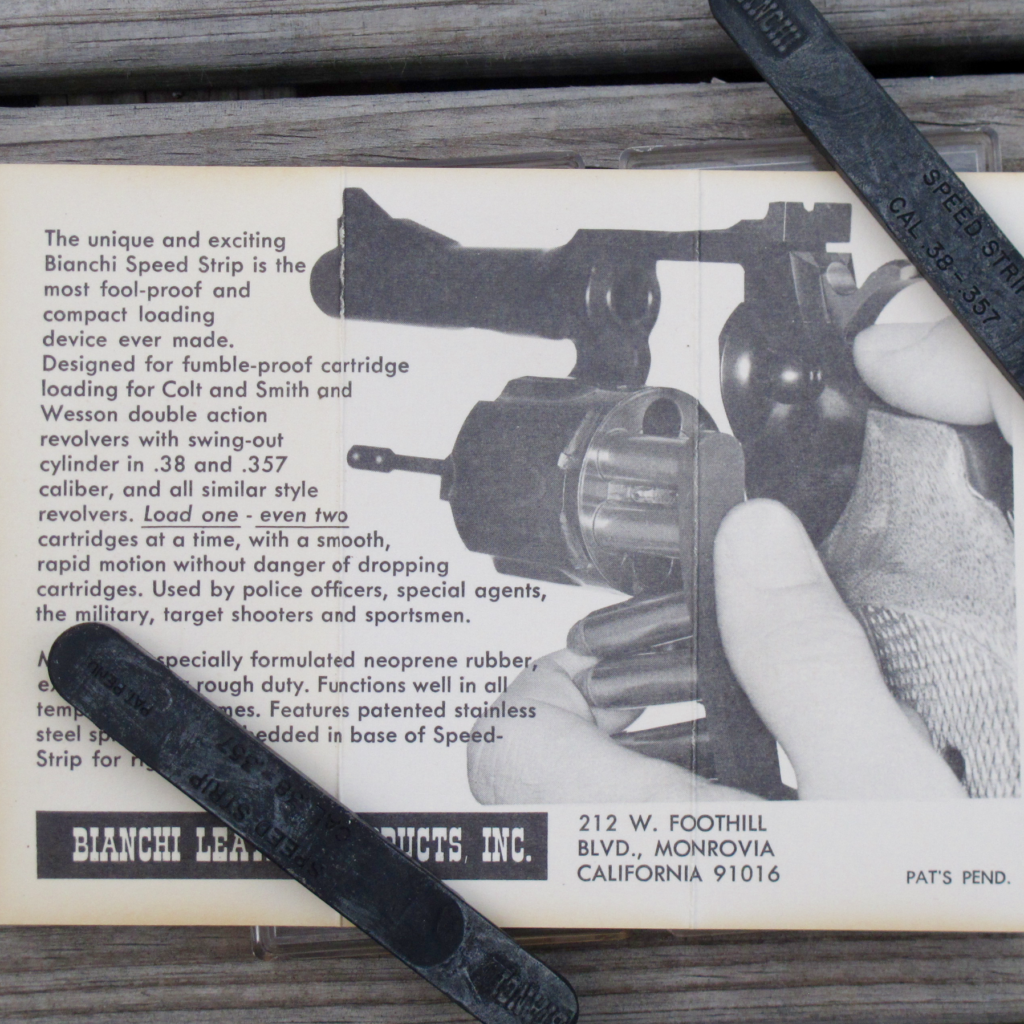
The Wheel(gun) Turns
There were other speedloader designs in this era, but these seven were the leading contenders after the terrible Newhall gunfight focused police attention on upgrading their equipment during the tumultuous and violent decade of the 1970s.
By the mid-1980s, the wheel of progress had turned again, and autoloaders had begun to replace revolvers in police duty holsters, but that didn’t stop the development of more advanced and efficient speedloader designs, like the Safariland Comp series (Patented by David A. Johnson, in January of 1978) and the SL Variant (patented in Germany by Gerhard Longwitz in April of 1995, and in the United States in September of 1999) that we enjoy today.
Yet, as popular as these new loaders are, they still aren’t as widely used as the HKS and the Speed Strip–two designs that were there at the beginning, and which continue to do yeoman’s duty for a new generation of wheelgunners today.

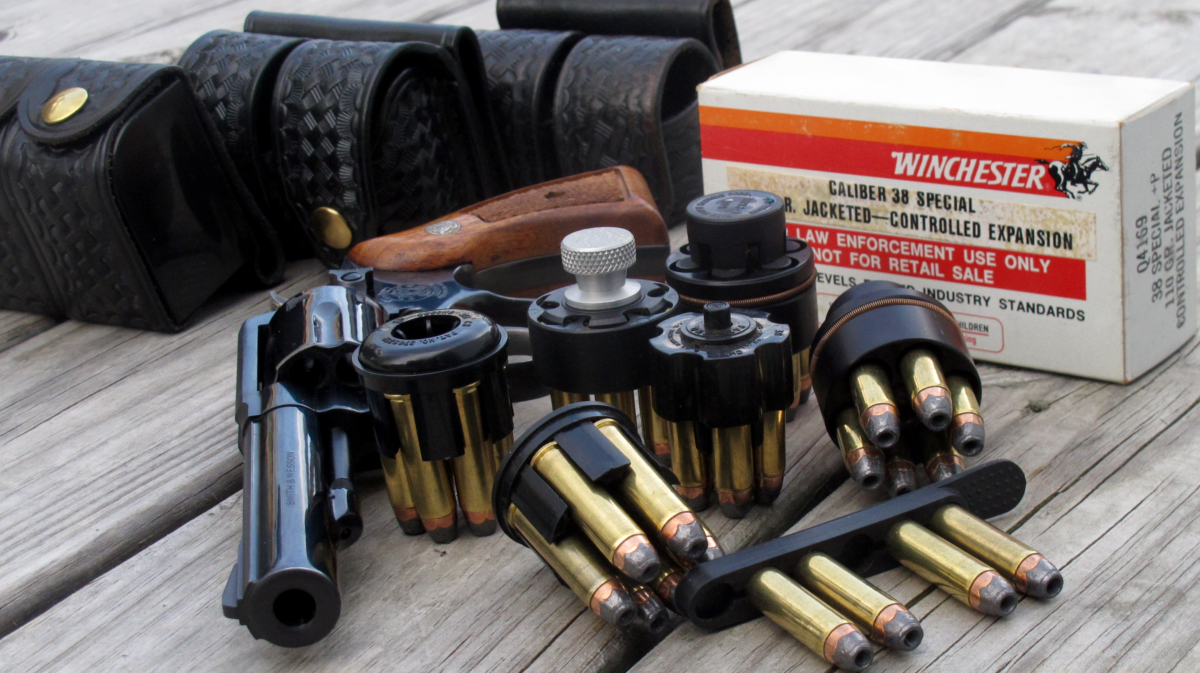
Your stuff is always a nice read Mike!
Great in depth info from this blog as usual…..
The SL Variant is my all time classic speed loader, especially in 5 round with the sport extension. I can fit 2 of them side by side with extensions in my magazine pocket on my cargo pants.
The hands down BEST for 6 shooters is the Wrapid Loader, stores flat like a speed strip and loads fast like a zip loader. Looks cool too.
After reading your excellent book about the Newhall shooting, I purposely stop what I’m doing to read anything I find with your name attached. This article didn’t disappoint! Thank you!
Early speedloaders appeared not long after the first top-break and swing-open cylinder revolvers hit the market in the late 19th Century.
For instance, Rollin White filed multiple patents for belt-mounted, multiple refill speedloaders for top-break revolvers.
https://www.google.com/patents/US201855
https://www.google.com/patents/US202613
Probably one of the first designs that would be fairly relevant even today is this one from 1879.
https://www.google.com/patents/US223100
Even major manufacturers like Colt got in on the act. Here is Colt’s cartridge pack patent from 1889.
https://www.google.com/patents/US402424
Here’s the famous Prideaux device intended primarily for the top-break Webley revolvers.
https://www.google.com/patents/US516942
However, their popularity didn’t increase until PPC competition started to hit an equipment race in the 1960s and ’70s. A few forward thinking officers thought that if the speedloaders worked for competition, why not use them on the street?
One of the earliest to become popular in the 1960s was the Hunt Multi-Loader, later marketed by Safariland and Kel-Lite. Hunt’s design was a cup-shaped piece of rubber that held the cartridges on the outer bottom surface. The cartridge rims were retained much like the later Bianchi Speed Strip. You inserted the rounds together into the cylinder, and then peeled the loader off. However, it was easier said than done. If you weren’t careful, the act of peeling would pull a few cartridges back out of the chamber.
https://www.google.com/patents/US2896353
https://www.google.com/patents/US4079536
The Matich Quick Loader was sort of like a sideways Bianchi Speed Strip with flanges sticking up from one side. You would roll the strip into a circle and these flanges formed six ‘chambers’. You could then force a cartridge in each of these holes. To speedload, you would start the cartridges into the cylinder and then peel the strip off. As the strip unrolled, the flanges would pull apart allowing the cartridges to drop into the cylinder.
https://www.google.com/patents/US3213559
Before finding the patent, I had only seen pictures of the Bye Speed Loading System with just the sketchiest of details. Its selling point was that it had no springs, screw, cams, or ratchets. The high price could not have helped sales. In 1978, it was 3 to 4 times as expensive as competing products.
https://www.google.com/patents/US3252238
I believe the following is that patent for what became the Bianchi Speed Strip.
https://www.google.com/patents/US3538636
The Dade Loader was extremely popular among PPC shooters. The case rims were retained by an elastic O-ring along the outer diameter of the loader. You started the cartridges in the chamber, the loader would bottom out, and then you pressed the center knob which would force the rims past the O-ring. The downside to the Dade was its fat diameter interfered with the stocks and thumbpieces. Worse yet, it would easily lose the cartridges when dropped.
https://www.google.com/patents/US3541716
Here is the original patent for the HKS ‘Six Second’ speedloader. These original models would later be dubbed the M-model after the introduction of the improved A and B models.
https://www.google.com/patents/US3722125
The B-model HKS were short lived, combining the automatic release of the Safariland Comp I while retaining the option of manual twist release like the legacy M and A models. The A-models were manual release only, but covered the primers like the B-Models.
https://www.google.com/patents/US4202124
The Kubik Speed Reloader was an odd piece of equipment. The cartridges were held in place by spring tension in three staggered tiers. The cartridges could be inserted from one side of the loader only. You started the cartridges in the chambers and then pulled the loader out to the side.
https://www.google.com/patents/US3824729
David Johnson’s JFS speedloader design quickly gained a following on the West Coast amongst PPC shooters. At the time, Johnson was reportedly making them in his garage. In an interview published in 1980, Safariland’s president Neale Perkins credited PPC revolversmith Bill Davis with tipping him off to the JFS design. Safariland picked up the design, where it was ultimately named the Comp I. Perkins stated that they sold 50,000 of the K2 Comp I loaders within the first 9 months of its introduction.
https://www.google.com/patents/US4065868
I don’t have a patent for the improved Comp II, but Johnson would later follow up with his answer to the Austrian Jet-Loader. Safariland still markets this as the Comp III.
https://www.google.com/patents/US4866870
The earliest mention I can find of the Jet-Loader being imported to the US was in 1981. Like other imported speedloaders, its availability seems to have been spotty.
https://www.google.com/patents/US4133129
The Second Six had nothing in common with the HKS ‘Six Second’. It consisted of two pieces of interlocking molded plastic. The inner portion retained the case rims through molded-in flanges; the outer portion was a ring that sat on top of the case heads when loaded. You would start the cartridges into the cylinder, and then force the outer ring towards the cylinder. This would force the case rims past the flanges. The upside was that this loader was extremely narrow in diameter. The downside was that depending on the gun model; forcing the tiny outer ring down was nearly impossible. Moreover, the firm would only sell direct to agencies and individual LEOs.
https://www.google.com/patents/US4272903
Compared to the others listed, the S.L. Variant is a fairly new design. It is closer to the Safariland Comp III in principle, but more like a Comp II in size. The case rims are held by independent fingers that cam in and out of the center body; moreover, each case head is backed by an individual spring. When the loader hits the extractor star, the fingers cam out of the way, and the springs toss the cartridges into the chambers. The best feature of this loader is the ease of inserting and locking individual rounds…no jiggling or twisting, just push each one into place. The downside is the cost and availability.
https://www.google.com/patents/US5953845
FYI: Here is Ole N. Olson’s patent for the Bucheimer/Feathertouch.
https://www.google.com/patents/US3197907
Here is a second patent from William Bye related to the Bye speedloader.
https://www.google.com/patents/US3503150
I also missed William Griffis’ original patent for the Second Six speedloader.
https://www.google.com/patents/US3769732
Daniel,
Thank you for taking the time to share such a wealth of information!
Justin
Glad to help. I’ve been assembling that list for years.
BTW: Here is another design originally sold for the Webley revolvers.
https://www.google.com/patents/US527166
I remember Mel Tappan pushing the Second Six in his by now very dated Survival Guns book. He had a special deal with the manufacturer so his readers could buy them.
Excellent article. It seems only following tragedy does technique and equipment move forward. I only use speed strips as a small revolver is a deep concealment gun for me but if I were using a service revolver on a belt (gone are the days of course) I would use belt-worn speedloaders for sure. The best of a bad situation, honestly.
Some nice additional insight here.
Although they may be obsolete for primary LE street use, revolvers still hold a pretty solid corner of the trail and mountain gun genre. A .357 or .44 sized revolver is more often than not what is seen where horses are more common than cars. Recently spent a week in AK and along with a lever gun, a big bore revolver is what I saw. I didnt ask if they used speedloaders though…
Now I really feel old! I started using HKS as well as Speed strips, when I started on patrol when I graduated from the Academy in 1977. I still use them both for my reloads.
I’ve no desire to change to anything else at this point. They work well for me.
There’s a lot to be said for sticking with the tried and true, TP.
I’ve lost track of the number of shooters I’ve seen with the latest technology, but no skill to use it. Give me a grizzled vet with a Model 10 and an HKS loader over an internet-trained whiz kid with a megablaster2000 and a chest rig full of magazines any day!
The Second Six loader was issued to us in the LASD academy followed 20 minutes later by the staff telling us they were garbage and to go out and buy Safariland or HKS. 90% purchased Safariland. I never saw a single deputy using a Second 6 in the field. As you point out drop the loader and the rounds fly out. Still use Safariland or for a 7 shot L frame the SLVariant which functions like a Safariland
I wish the SL Variant loaders made from “unobtainium” were available! Those are a dandy design.
Dirty Harry used the Dade, enough said !
The “original” speedloader -in conception, at least- might well be the extra loaded cylinder or two carried by some users of Colt percussion cap revolvers. Each chamber was charged with powder and ball and had a cap in place. These are most famously associated with riders of the quite short-lived “Pony Express” but were surely used by others needing a quick reload in tight circumstances. A man with two pistols and two extra cylinders had 24-rounds at hand, quite a bit of firepower in the mid-19th Century!
I read as many articles as I can on handling technique, real world shooting situations, etc. Like many, I have a parchment for articles by Massad Ayoob. He wrote up a good review of the Newhall shootings many years ago. In a more recent article, he covered a 70’s era shoot out between a detective and a felon. The LEO was using a 38 snub nose and reloaded with a single Hunt speed loader (left the other one back at the office!). While I imagined what they looked like; it was nice to see a picture of the actual item. It just about matched what I imagined. As for me, HKS all the way – though I always check to see if they clear the grips.
Thank you for the article. Starting LE in the mid 70’s, I went from a S&W model 28 to a model 19, then to a model 10 with another agency (where I spent 30+ years). I loved the Dade speedloaders and was looking around for them today for a Ruger LCR. I carried the Dades and the Bianchi Speed Strips. The Dades were very quick. I shot thousands of rounds of wadcutters with them. You had to be precise to load them in the cylinder, so the duty JHPs were very quick.
When at S&W’s armorer course for single/double action pistols in 2001, I was surprised to hear that the LE revolver was still their bread and butter at that time.
Thanks Phil, glad to have you here! I love the Dade loader and agree it’s very fast. I hope you kept all those great revolvers when you went from one to the next–it would be a great collection today!
I was told the same thing in the LASD Academy. The county just bought cheap loaders, pouches & even cheaper plastic flash lights that would break if dropped once. The staff advised us to get the Safariland speed loaders over the HKS because the individual rounds wiggled in the HKS loaders while the Safariland loaders held the rounds nice and tight making it quicker to insert the rounds into the cylinder. We also had to buy new pouches that cost about $24.00 because neither the Safariland or HKS loaders would fit into the issued pouches. Few Deputies continued to use the Second Six loaders and some bought leather pouches that held 3 speed loaders (lined up 3 loaders in a row on the belt) or 4 loaders (2 loaders on top & 2 on the bottom.) Safariland made a leather pouch that held 4 but there was another 4 loader pouch that held the bottom 2 loaders upside down with the snap flaps also opening upside down to allow the loader to drop into your hand. Some Deps also wore a leather pouch that held 4 or 5 shotgun shells. This added considerable weight and took up a lot of real estate on the Sam Browne belt!!! Consider it: revolver in Safety Speed or Hoyt break front holster, Shotgun shell pouch, speedloader pouch, PR-24 baton, Zenith 470 radio, keys, 2 handcuff pouches, knife pouch, flashlight all worn with a vest and heavy snug fitting uniform!! My back hurts just thinking about it!!!
Indeed! There’s a reason why so many cops have lower back pain, and it’s not just from the brass/media/politicians jumping on their back over every stupid little thing.
Some things never change—good cops still have to spend their own money to get quality equipment, because the department stuff often isn’t.
Thanks for writing. I hope you’ll stick around and enjoy some of the articles here on the site!
Hi:
When I was in law enforcement (1970 to 1990) we were issued two HKS speed loaders and a double pouch. I bought a pouch that had two on the top and two on the bottom bullets up for a total of six speed loaders.
Does anyone know where I can find any of these pouches?
Thanks
Hello Sir. I remember them, but nobody is still making them, that I’m aware of. There are some carriers that place three loaders side-by-side (the new Safariland 333, or some old Tex Shoemaker pouches that are still available from VintageGunLeatherToday), but those are not as space efficient as your old Quad pouch was, with two up top and two below.
I looked around on the eBay auction site to see if there were any old ones for sale, but didn’t find any.
I would suggest having a custom leather maker build one for you. Some places to start would be Rob Leahy at Simply Rugged Holsters, D. “Jeff” Jeffrey at Jeffrey Custom Leather, or Sam Andrews at Andrews Custom Leather. Any of these gents would do a good job building one for you, especially if you had an old photo to share with them.
If you find a better source, please let us know!
My department issued 150 rounds of LSWC .38 Special for our summer firearm qualification. If I recall correctly; 50 rounds for regimented practice, the next 50 was scored, and the final 50 was for the tactical course. Rather than have officers only utilize their patrol duty gear, a double leather dump pouch holding a total of 12 rounds, the Department loaned us carpenter’s aprons. That way officers could easily retrieve a handful of cartridges from the box of 50 rounds that was emptied into the “nail” pouch.
Practice and qualifying completed, I proceeded to the tactical range.
Cardboard targets were remotely controlled moving left or right, popping out from cover afforded by stacks of auto tires. We were instructed to take cover behind ordinary street objects: mailboxes, fire hydrants, etc… and open fire on “perps” when they became visible.
We were told to reload and get back on target as quickly as possible!
After firing six rounds, the targets went behind cover but quickly re-emerged while most officers were reloading. Only one fellow returned fire. This scenario was repeated again. I was able to return fire with 18 rounds when my colleagues were only able to get off six. A range instructor approached me and asked how I was able to reload so quickly. I showed him the pair of speedloaders in my apron. He returned to the control tower and spoke with his superior. I thought I might get suspended for using unauthorized gear. Surprisingly, they left me alone.
I continued to wear a pair of speed loaders and the double dump pouch on my gunbelt while on patrol in my precinct, giving me 4 reloads. Naturally, I also wore my back up revolver in an ankle holster.
This was in the early 1980s. A few years later, the father of a slain police officer held up a speedloader for TV cameras and asked the mayor and P.C. If this $10 item may have been able to save his son’s life. Within weeks of P.O. Scott Gadell’s murder, while he was trying to reload from a dump pouch, speed loaders were finally authorized- at the officers’ expense.
Opa, thanks a million for your story. I’m sure the instructors out at Rodman’s Neck were all on your side, but secretly hoped none of the brass would find out, and come down on them.
I just finished a story about Scott that will run later this year. Your timing couldn’t have been better. We’re on the same wavelength, the two of us.
I’ve seen other MOS discuss that they carried speedloaders prior to the 1986 authorization, and didn’t catch any flak over them, but it’s hard for me to get a feel of how common that was. If you had to guess, what percentage carried the speedloaders outside of policy? 1%? Slightly more? I’m sure it wasn’t many, but the guys who were switched on certainly didn’t care about the guide, when it came to important things like that.
Mike,
A good number of city cops were city kids and not raised around guns. I started shooting in the Boy Scouts and got hooked at an early age. I’d estimate that less than 10% of the force openly wore speed loaders on their gun belts. One officer referred to me as “Clint” when he noticed my pair of HKS speed loaders. My sergeant never objected to or even mentioned my speed loaders at roll call.
In my Bronx precinct nearly every patrol and anti-crime officer carried two revolvers when on duty. Heck, one steady midnight tour officer wore a .357 magnum crossdraw opposite his .38 special six shooter on his strong side.
We knew we were in a combat zone. NYPD didn’t issue shotguns or rifles to cops on patrol. Only ESU and Highway had better firepower.
Sacrifices by P.O. Gadell, as horrible as they were, eventually led to better training and equipment for the rest of NYPD.
Thank you Sir, very enlightening! I’m going to send you an email, to follow up.
Thank you very much for this most useful article. Have a long used the HK. Have one day that I very much like. Would love to find some more of them. Based on this article, will need to find some speed strips and give them a try.